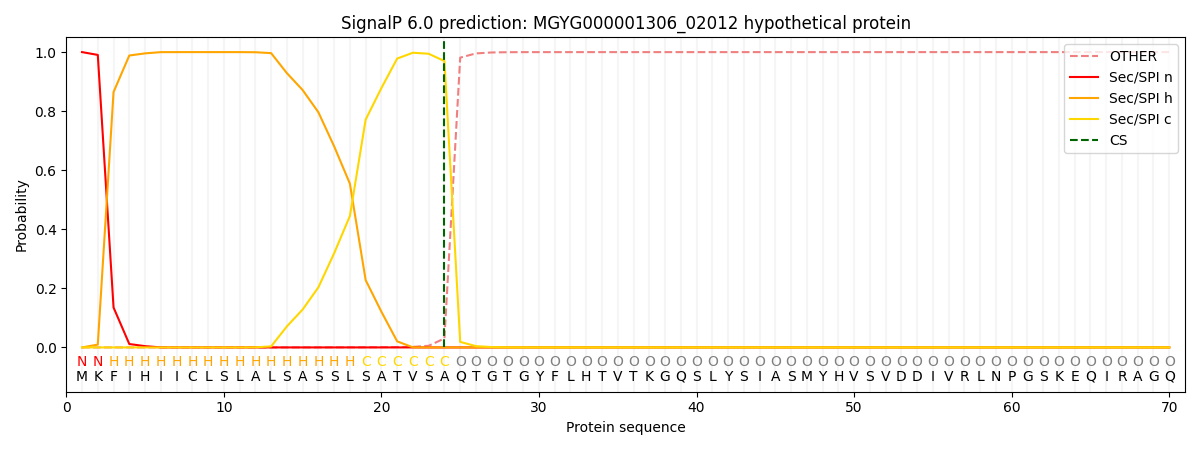You are browsing environment: HUMAN GUT
CAZyme Information: MGYG000001306_02012
You are here: Home > Sequence: MGYG000001306_02012
Basic Information |
Genomic context |
Full Sequence |
Enzyme annotations |
CAZy signature domains |
CDD domains |
CAZyme hits |
PDB hits |
Swiss-Prot hits |
SignalP and Lipop annotations |
TMHMM annotations
Basic Information help
| Species | Phocaeicola coprocola | |||||||||||
|---|---|---|---|---|---|---|---|---|---|---|---|---|
| Lineage | Bacteria; Bacteroidota; Bacteroidia; Bacteroidales; Bacteroidaceae; Phocaeicola; Phocaeicola coprocola | |||||||||||
| CAZyme ID | MGYG000001306_02012 | |||||||||||
| CAZy Family | CBM50 | |||||||||||
| CAZyme Description | hypothetical protein | |||||||||||
| CAZyme Property |
|
|||||||||||
| Genome Property |
|
|||||||||||
| Gene Location | Start: 26764; End: 28542 Strand: - | |||||||||||
CDD Domains download full data without filtering help
| Cdd ID | Domain | E-Value | qStart | qEnd | sStart | sEnd | Domain Description |
|---|---|---|---|---|---|---|---|
| cd00118 | LysM | 1.56e-10 | 33 | 74 | 3 | 45 | Lysin Motif is a small domain involved in binding peptidoglycan. LysM, a small globular domain with approximately 40 amino acids, is a widespread protein module involved in binding peptidoglycan in bacteria and chitin in eukaryotes. The domain was originally identified in enzymes that degrade bacterial cell walls, but proteins involved in many other biological functions also contain this domain. It has been reported that the LysM domain functions as a signal for specific plant-bacteria recognition in bacterial pathogenesis. Many of these enzymes are modular and are composed of catalytic units linked to one or several repeats of LysM domains. LysM domains are found in bacteria and eukaryotes. |
| cd00118 | LysM | 5.25e-10 | 86 | 130 | 1 | 45 | Lysin Motif is a small domain involved in binding peptidoglycan. LysM, a small globular domain with approximately 40 amino acids, is a widespread protein module involved in binding peptidoglycan in bacteria and chitin in eukaryotes. The domain was originally identified in enzymes that degrade bacterial cell walls, but proteins involved in many other biological functions also contain this domain. It has been reported that the LysM domain functions as a signal for specific plant-bacteria recognition in bacterial pathogenesis. Many of these enzymes are modular and are composed of catalytic units linked to one or several repeats of LysM domains. LysM domains are found in bacteria and eukaryotes. |
| PRK06347 | PRK06347 | 1.49e-09 | 32 | 222 | 332 | 544 | 1,4-beta-N-acetylmuramoylhydrolase. |
| PRK06347 | PRK06347 | 1.60e-09 | 23 | 185 | 398 | 576 | 1,4-beta-N-acetylmuramoylhydrolase. |
| smart00257 | LysM | 1.94e-09 | 33 | 74 | 2 | 44 | Lysin motif. |
CAZyme Hits help
| Hit ID | E-Value | Query Start | Query End | Hit Start | Hit End |
|---|---|---|---|---|---|
| QRO25583.1 | 5.90e-317 | 1 | 592 | 1 | 601 |
| ALA74972.1 | 1.77e-254 | 1 | 592 | 1 | 602 |
| QQY43886.1 | 2.51e-254 | 1 | 592 | 1 | 602 |
| QJR68229.1 | 1.01e-253 | 1 | 592 | 1 | 602 |
| QJR60047.1 | 1.01e-253 | 1 | 592 | 1 | 602 |
Swiss-Prot Hits download full data without filtering help
| Hit ID | E-Value | Query Start | Query End | Hit Start | Hit End | Description |
|---|---|---|---|---|---|---|
| P44493 | 8.30e-08 | 33 | 196 | 294 | 424 | Probable N-acetylmuramoyl-L-alanine amidase AmiB OS=Haemophilus influenzae (strain ATCC 51907 / DSM 11121 / KW20 / Rd) OX=71421 GN=amiB PE=3 SV=1 |
| O05495 | 1.87e-07 | 31 | 140 | 2 | 102 | Putative sporulation-specific glycosylase YdhD OS=Bacillus subtilis (strain 168) OX=224308 GN=ydhD PE=1 SV=2 |
| P0C1U7 | 1.77e-06 | 12 | 238 | 8 | 231 | N-acetylmuramoyl-L-alanine amidase sle1 OS=Staphylococcus aureus OX=1280 GN=sle1 PE=3 SV=1 |
| Q2FJH7 | 1.77e-06 | 12 | 238 | 8 | 231 | N-acetylmuramoyl-L-alanine amidase sle1 OS=Staphylococcus aureus (strain USA300) OX=367830 GN=sle1 PE=3 SV=1 |
| Q2G0U9 | 1.77e-06 | 12 | 238 | 8 | 231 | N-acetylmuramoyl-L-alanine amidase sle1 OS=Staphylococcus aureus (strain NCTC 8325 / PS 47) OX=93061 GN=sle1 PE=1 SV=1 |
SignalP and Lipop Annotations help
This protein is predicted as SP

| Other | SP_Sec_SPI | LIPO_Sec_SPII | TAT_Tat_SPI | TATLIP_Sec_SPII | PILIN_Sec_SPIII |
|---|---|---|---|---|---|
| 0.000231 | 0.999124 | 0.000168 | 0.000164 | 0.000145 | 0.000135 |
